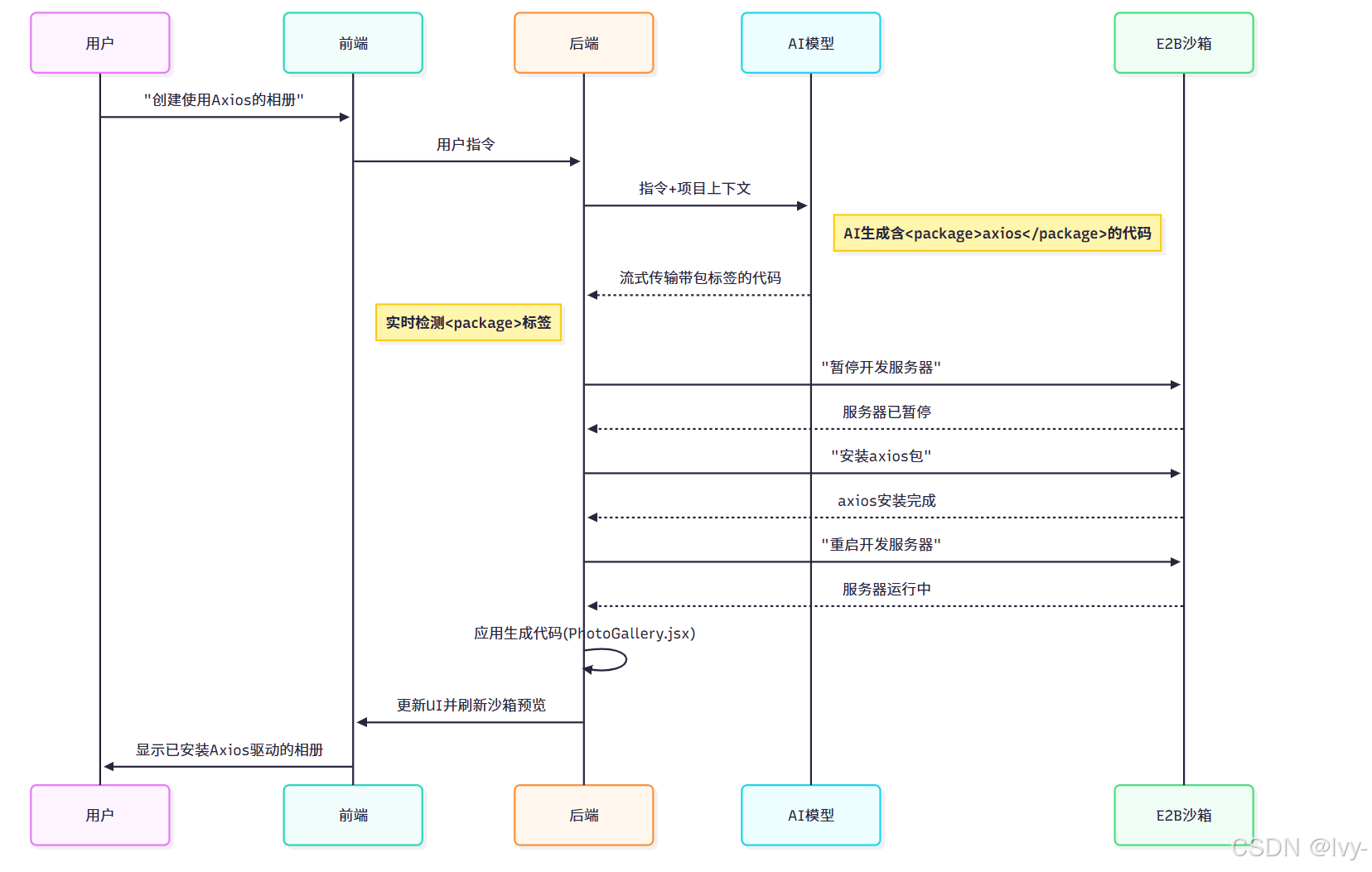第七章:包与依赖管理
在我们使用open-lovable的旅程中,已经探索了它如何管理对话状态(第一章:对话状态管理)、将创意转化为可运行代码(第二章:AI代码生成管道)、如何在安全的虚拟环境中执行代码(第三章:E2B沙箱交互),以及它如何理解现有项目(第四章:代码库理解)。
我们还看到它如何智能选择修改内容(第五章:编辑意图与上下文选择)和从网页重构设计(第六章:网页抓取与设计输入)。
但当AI生成精彩代码后,在运行前还有关键一步:确保所有"原料"准备就绪。
想象我们请求一位超级智能厨师(AI)烘焙新型蛋糕。厨师写下配方(代码),这个配方可能需要"香草精"或"泡打粉"等特殊原料(相当于外部库或"包")。如果厨房(项目环境)缺少这些原料,蛋糕(应用)就无法成型!
这就是包与依赖管理的用武之地。它如同open-lovable的专属厨房助手,确保项目拥有运行所需的所有外部构件(如react、axios、framer-motion或@heroicons/react),能自动识别代码需要的包并在隔离环境(E2B沙箱)中直接安装。
核心问题:缺失原料
假设我们请求open-lovable:“创建从API获取图片的简易相册”
AI可能生成如下代码(简化版):
import React, { useEffect, useState } from 'react';
import axios from 'axios'; // 关键行!
function PhotoGallery() {
const [images, setImages] = useState([]);
useEffect(() => {
axios.get('https://api.example.com/photos')
.then(response => setImages(response.data))
.catch(error => console.error('获取图片错误:', error));
}, []);
return (
<div>
{images.map(img => <img key={img.id} src={img.url} alt={img.title} />)}
</div>
);
}
export default PhotoGallery;
注意这行:import axios from 'axios';
如果项目未安装axios包,代码会立即抛出"找不到模块"错误。包与依赖管理通过自动检测并安装所需包,让代码直接运行。
核心概念
open-lovable以智能化方式处理包管理:
- 包(库):他人创建共享的预编写代码,避免重复造轮。如
axios处理网络请求,framer-motion实现动画 - 依赖:代码运行所"依赖"的包
- 自动检测:
- AI显式标注:AI在输出中通过特殊标签声明所需包(主要可靠方式)
- 导入语句扫描:扫描代码中的
import/require语句推测需求
- 沙箱安装:使用
npm等工具在E2B沙箱中直接安装 - 去重机制:安装前检查已有包,避免重复安装
库
axios
是一个基于 Promise 的 HTTP 客户端,用于浏览器和 Node.js,能轻松发送异步请求并处理响应数据。
安装 axios
在项目中使用 axios 前,需要先安装它。可以通过 npm 或 yarn 安装:
npm install axios
# 或
yarn add axios
发起 GET 请求
axios 支持多种 HTTP 请求方法,GET 是最基础的一种。以下是一个简单的 GET 请求示例:
const axios = require('axios');
axios.get('https://jsonplaceholder.typicode.com/posts/1')
.then(response => {
console.log(response.data);
})
.catch(error => {
console.error('Error fetching data:', error);
});
发起 POST 请求
如果需要向服务器发送数据,可以使用 POST 请求:
axios.post('https://jsonplaceholder.typicode.com/posts', {
title: 'foo',
body: 'bar',
userId: 1
})
.then(response => {
console.log(response.data);
})
.catch(error => {
console.error('Error posting data:', error);
});
设置请求配置
axios 允许通过配置对象自定义请求行为,例如设置超时或请求头:
axios.get('https://jsonplaceholder.typicode.com/posts', {
timeout: 5000,
headers: { 'X-Custom-Header': 'foobar' }
})
.then(response => {
console.log(response.data);
});
处理并发请求
如果需要同时发起多个请求,可以使用 axios.all:
axios.all([
axios.get('https://jsonplaceholder.typicode.com/posts/1'),
axios.get('https://jsonplaceholder.typicode.com/posts/2')
])
.then(axios.spread((response1, response2) => {
console.log(response1.data, response2.data);
}));
拦截请求和响应
axios 提供了拦截器功能,可以在请求或响应被处理前进行拦截:
axios.interceptors.request.use(config =>
{
console.log('Request sent:', config.url);
return config;
}, error => {
return Promise.reject(error);
});
axios.interceptors.response.use(response =>
{
console.log('Response received');
return response;
}, error => {
return Promise.reject(error);
});
取消请求
axios 支持取消请求,适用于用户取消操作或组件卸载时中止请求:
const source = axios.CancelToken.source();
axios.get('https://jsonplaceholder.typicode.com/posts/1', {
cancelToken: source.token
})
.catch(error => {
if (axios.isCancel(error)) {
console.log('Request canceled:', error.message);
}
});
source.cancel('Operation canceled by the user.');
错误处理
通过 catch 捕获请求中的错误,并区分不同类型的错误:
axios.get('https://jsonplaceholder.typicode.com/posts/invalid')
.catch(error => {
if (error.response) {
console.error('Server responded with error status:', error.response.status);
} else if (error.request) {
console.error('No response received:', error.request);
} else {
console.error('Error setting up request:', error.message);
}
});
使用 async/await
axios 支持 async/await 语法,使异步代码更易读:
async function fetchData() {
try {
const response = await axios.get('https://jsonplaceholder.typicode.com/posts/1');
console.log(response.data);
} catch (error) {
console.error('Error:', error);
}
}
fetchData();
framer-motion
一个用于 React 的动画库,能轻松创建流畅的交互式动画和复杂的手势效果。
安装 framer-motion
通过 npm 或 yarn 安装 framer-motion:
npm install framer-motion
# 或
yarn add framer-motion
基本动画实现
导入 motion 组件并定义动画属性:
import { motion } from "framer-motion";
function App() {
return (
<motion.div
animate={{ x: 100, rotate: 360 }}
transition={{ duration: 2 }}
>
旋转移动的方块
</motion.div>
);
}
animate定义目标状态(如位移、旋转)。transition控制动画时长和缓动效果。
关键帧动画
通过数组定义多阶段关键帧:
<motion.div
animate={{
x: [0, 100, -50, 0],
opacity: [1, 0.5, 1]
}}
transition={{ duration: 3 }}
/>
数组中的每个值为动画序列的关键帧。
交互触发动画
结合用户交互(如悬停、点击):
<motion.button
whileHover={{ scale: 1.1 }}
whileTap={{ scale: 0.9 }}
>
点击我
</motion.button>
whileHover:悬停时触发。whileTap:点击时触发。
路径绘制动画
使用 pathLength 属性实现 SVG 路径绘制效果:
<motion.svg
viewBox="0 0 100 100"
>
<motion.path
d="M0,0 L100,100"
stroke="black"
initial={{ pathLength: 0 }}
animate={{ pathLength: 1 }}
transition={{ duration: 2 }}
/>
</motion.svg>
布局动画
自动平滑过渡布局变化:
<motion.div layout>
{isExpanded && <motion.p layout>更多内容</motion.p>}
</motion.div>
添加 layout 属性即可启用布局动画。
滚动触发动画
结合 useScroll 实现视差效果:
import { useScroll, motion } from "framer-motion";
function Component() {
const { scrollYProgress } = useScroll();
return (
<motion.div
style={{ scaleX: scrollYProgress }}
/>
);
}
scrollYProgress 返回 0-1 的滚动进度值。
退出动画
配合 React 组件卸载时的动画:
import { AnimatePresence } from "framer-motion";
function Modal({ isOpen }) {
return (
<AnimatePresence>
{isOpen && (
<motion.div
initial={{ opacity: 0 }}
animate={{ opacity: 1 }}
exit={{ opacity: 0 }}
>
弹窗内容
</motion.div>
)}
</AnimatePresence>
);
}
AnimatePresence 用于管理组件卸载动画。
手势拖拽
实现可拖拽元素:
<motion.div
drag
dragConstraints={{ left: 0, right: 0, top: 0, bottom: 0 }}
/>
dragConstraints 限制拖拽范围。
注意事项
- 性能优化:避免同时激活过多复杂动画。
- 移动端适配:部分手势功能需测试触摸设备兼容性。
- 组件层级:确保
AnimatePresence直接包裹动态组件。
包处理流程

底层实现
1. AI声明需求(XML标签)
open-lovable指导AI在代码生成输出中使用XML式标签,这是可靠的通信方式(详见第二章系统提示词):
使用包前必须用<package>标签声明
示例:<package>three</package> 或 <package>@heroicons/react</package>
也可用<packages>标签批量声明:
<packages>
react-router-dom
axios
framer-motion
</packages>
AI响应示例:
<explanation>
这是使用axios的新相册组件
</explanation>
<package>axios</package>
<file path="src/components/PhotoGallery.jsx">
import React, { useEffect, useState } from 'react';
import axios from 'axios';
// ...组件代码
</file>
2. 从AI输出检测包
后端实时扫描流式文本中的包标签(见app/api/generate-ai-code-stream/route.ts):
// 流式处理逻辑(简化)
let tagBuffer = '';
for await (const textPart of result.textStream) {
tagBuffer += textPart;
// 正则匹配包标签
const packageRegex = /<package>([^<]+)<\/package>/g;
const packagesRegex = /<packages>([\s\S]*?)<\/packages>/g;
// 处理单个包标签
while ((match = packageRegex.exec(tagBuffer)) !== null) {
const pkg = match[1].trim();
if (!packagesToInstall.includes(pkg)) {
packagesToInstall.push(pkg);
await sendProgress({ type: 'package', name: pkg });
}
}
// 处理批量包声明
while ((match = packagesRegex.exec(tagBuffer)) !== null) {
const pkgs = match[1].split(/[\n,]/).map(p => p.trim());
pkgs.forEach(pkg => {
if (!packagesToInstall.includes(pkg)) {
packagesToInstall.push(pkg);
await sendProgress({ type: 'package', name: pkg });
}
})
}
}
3. 从文件导入检测包(备用验证)
app/api/detect-and-install-packages/route.ts通过正则扫描导入语句:
// 导入检测逻辑(简化)
const importRegex = /import\s+.*?from\s+['"]([^'"]+)['"]/g;
const requireRegex = /require\s*\(['"]([^'"]+)['"]\)/g;
for (const [filePath, content] of Object.entries(files)) {
if (!/\.(jsx?|tsx?)$/.test(filePath)) continue;
let match;
while ((match = importRegex.exec(content)) !== null) {
imports.add(match[1]);
}
while ((match = requireRegex.exec(content)) !== null) {
imports.add(match[1]);
}
}
// 过滤本地路径和内置模块
const uniquePackages = [...new Set([...imports]
.filter(p => !p.startsWith('.') && !p.startsWith('/'))
.map(p => p.startsWith('@') ? p.split('/').slice(0,2).join('/') : p.split('/')[0])
)];
4. 沙箱内安装包
app/api/install-packages/route.ts处理实际安装:
// 安装流程(简化)
export async function POST(request: NextRequest) {
const { packages, sandboxId } = await request.json();
// 1. 检查已安装包
const checkScript = `
// 读取package.json比对依赖
const dependencies = require('./package.json').dependencies || {};
const needInstall = ${JSON.stringify(packages)}.filter(p => !dependencies[p.split('@')[0]]);
console.log('NEED_INSTALL:' + JSON.stringify(needInstall));
`;
const { stdout } = await sandbox.runCode(checkScript);
const packagesToInstall = JSON.parse(stdout.match(/NEED_INSTALL:(.*)/)[1]);
// 2. 暂停开发服务器
await sandbox.runCode(`
const { execSync } = require('child_process');
execSync('pkill -f "vite|next"');
`);
// 3. npm安装
if (packagesToInstall.length > 0) {
await sandbox.runCode(`
const { execSync } = require('child_process');
execSync('npm install --legacy-peer-deps ${packagesToInstall.join(' ')}', { stdio: 'inherit' });
`);
}
// 4. 重启服务器
await sandbox.runCode(`
const { spawn } = require('child_process');
const vite = spawn('npm', ['run', 'dev'], { detached: true });
fs.writeFileSync('/tmp/vite.pid', vite.pid.toString());
`);
}
智能包管理的优势
- 零配置:无需手动执行
npm install - 零报错:预防"模块未找到"错误
- 实时反馈:安装进度可视化
- 高效开发:自动化处理保障流畅体验
- 可靠环境:确保依赖版本一致性
结语
本章揭示了open-lovable如何通过智能包管理充当开发助手,从AI输出和代码导入中检测依赖,在E2B沙箱中自动化安装,最终实现"原料完备即用"的无缝开发体验。这种自动化机制是构建高效AI开发流程的核心要素。
END ★,°:.☆( ̄▽ ̄).°★ 。